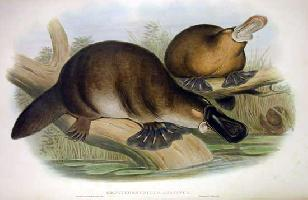
Starea de conservare
| Disparut |
Descrierea animalului
The Riversleigh platypus, scientifically known as Obdurodon dicksoni, is an extinct species of monotreme that once inhabited Australia, particularly in the area known today as the Riversleigh World Heritage Area in Queensland. This fascinating creature lived during the Miocene epoch, which dates from about 23 to 5.3 million years ago, providing valuable insights into the evolutionary history of modern platypuses and the ecological dynamics of ancient Australian environments.Obdurodon dicksoni was notably larger than its modern-day counterpart, the extant platypus (Ornithorhynchus anatinus). While the contemporary platypus measures about 50 cm in length, the Riversleigh platypus could reach lengths of over 60 cm, indicating a significant size difference that hints at a different lifestyle and ecological niche. This ancient species retained several distinctive features of modern platypuses, such as a duck-bill-like snout, webbed feet, and a semi-aquatic lifestyle, but with notable differences that underscore its unique place in the evolutionary lineage.
One of the most remarkable aspects of Obdurodon dicksoni is its teeth. Unlike the modern platypus, which loses its teeth in adulthood, retaining only horny pads for grinding food, the Riversleigh platypus possessed permanent, molar-like teeth throughout its life. These teeth were complex and designed for crushing, suggesting that Obdurodon dicksoni had a varied diet that could have included not only small aquatic invertebrates, like the diet of its modern relatives, but potentially also harder-shelled prey such as mollusks and crustaceans found in the rivers and lakes of Miocene Australia.
The habitat of Obdurodon dicksoni was likely a lush, wetland environment, rich in both aquatic and terrestrial biodiversity. The Riversleigh area, where fossils of this species have been predominantly found, is known for its exceptionally well-preserved fossil sites that paint a vivid picture of the ancient ecosystems of Australia. These wetlands would have provided an ideal setting for the Riversleigh platypus, offering abundant food sources and habitats conducive to its semi-aquatic lifestyle.
The discovery and study of Obdurodon dicksoni fossils have been instrumental in understanding the evolutionary history of monotremes, a unique group of egg-laying mammals that today includes only the platypus and the echidnas. By examining the physical characteristics and potential behaviors of this extinct species, scientists can infer the evolutionary pressures and environmental changes that have shaped the development of these distinctive creatures over millions of years.
In summary, the Riversleigh platypus, Obdurodon dicksoni, represents a fascinating chapter in the story of mammalian evolution in Australia. Its existence provides evidence of the diverse and dynamic ecosystems of the Miocene epoch, and its unique anatomical features offer insights into the evolutionary trajectory of one of the most unusual and intriguing groups of mammals on the planet.
Animale similare
Fotografii noi cu animale
Top 10 animale
- Dolphin gull (Leucophaeus scoresbii)
- Diana monkey (Cercopithecus diana)
- Moustached guenon (Cercopithecus cephus)
- Galápagos tortoise (Geochelone nigra complex)
- Russian tortoise (Testudo horsfieldii)
- Stone loach (Barbatula barbatula)
- Japanese macaque (Macaca fuscata)
- Greek tortoise (Testudo graeca)
- Common flying dragon (Draco volans)
- Vendace (Coregonus albula)
